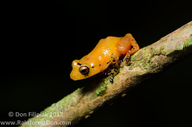|
Description
Diasporus citrinobapheus shows the following combination of characters: coloration bright yellow to orange in life; head almost as broad as long, but comparatively broad in relation to SVL; skin of dorsum smooth; venter coarsely areolate; tympanum covered by skin but annulus clearly visible; TD about 41% of ED; EL on average narrower than IOD; snout subacuminate in profile and rounded to subovoid in dorsal outline; disks of fingers and toes slightly expanded, disk covers of most fingers and toes spadate, but lacking papillae; disk pads of most fingers and toes triangular; subarticular tubercles of hands and feet rounded, very flat, almost not visible; vomerine odonthophores longish oval and widely separated; vomerine teeth weakly developed; upper eyelid usually smooth, very low pustules in some individuals; heel smooth (Hertz et al. 2012).
Coloration in life: All examined specimens show shades of bright yellow and orange dorsally; some have dark grayish and/or whitish-grayish spots. Ventral surfaces are transparent and almost entirely lacking yellow pigment apart from the yellow male vocal sac.
In preservation (70% alcohol), the bright yellow and orange colors fade rapidly to a pale grayish yellow with scattered dark grayish blotches in some individuals. Legs pale orange; vocal sac pale yellow in males; gular area in females pale gray; tips of digits dark grayish black. Dark grayish black eyeballs shining through skin when head is viewed dorsally (Hertz et al. 2012).
Variation: Compared to other species of this genus, the individuals of D. citrinobapheus available exhibit little variation in their coloration. All show a yellow to orange dorsal ground color in life. This can either appear bright and clear or somewhat dirty, depending on the pigment translocation within the melanophores in the frog’s skin. In some individuals, higher concentrations of melanophores in certain areas of the dorsum form dark blotches or stripes. This is especially the case in specimens from the western part of its known distribution area (Hertz et al. 2012).
Distribution and Habitat
Country distribution from AmphibiaWeb's database: Panama
D. citrinobapheus has been found on the Caribbean slopes of the western Serranía de Tabasará (Comarca Ngöbe-Buglé, Panama) and on both Pacific and Caribbean slopes of the eastern Serranía de Tabasará (Comarca Ngöbe-Buglé and Province of Veraguas, Panama) at intermediate elevations from 680 to 790 m a.s.l. It inhabits primary and secondary premontane forest, where it can be found in dense vegetation at night (Hertz et al. 2012). Life History, Abundance, Activity, and Special Behaviors
Males call from very dense vegetation. Vocal activity is highest just after dusk and finally stops when it becomes dark. Calling height ranges from near ground level up to three meters above ground. Calling position can be either on the upper side of a leaf or on its underside. The only known female was found at daytime inside an curled, young plantain leaf that apparently served as a daytime hiding place (Hertz et al. 2012). Trends and Threats
D. citrinobapheus has been detected in two protected areas: at Willie Mazú in the Bosque Protector Palo Seco reserve, and at Cerro Negro in the Santa Fé National Park. However, the Serranía de Tabasará overall is highly threatened by deforestation and habitat degradation (Hertz et al. 2012). Possible reasons for amphibian decline General habitat alteration and loss
Habitat modification from deforestation, or logging related activities
Habitat fragmentation
Comments
The species authorities for D. citrinobapheus are Hertz, A., Hauenschild, F., Lotzkat, S., and Köhler, G.
The specific name citrinobapheus is a noun in apposition and derived from the Greek words citrinos (citrin-yellow) and bapheus (dyer) referring to the yellow body color that stains one’s fingers yellowish when the frog is handled (Hertz et al. 2012).
References
Hertz, A., Hauenschild, F., Lotzkat, S., Köhler, G. (2012). ''A new, golden frog species of the genus Diasporus (Amphibia, Eleutherodactylidae) from the Cordillera Central, western Panama.'' ZooKeys, 196, 23–46.
Originally submitted by: Andreas Hertz (first posted 2012-07-31)
Edited by: Michelle S. Koo (2012-10-04)Species Account Citation: AmphibiaWeb 2012 Diasporus citrinobapheus: Yellow Dyer Rainfrog <https://amphibiaweb.org/species/7828> University of California, Berkeley, CA, USA. Accessed Jun 5, 2025.
Feedback or comments about this page.
Citation: AmphibiaWeb. 2025. <https://amphibiaweb.org> University of California, Berkeley, CA, USA. Accessed 5 Jun 2025.
AmphibiaWeb's policy on data use.
| 



 Map of Life
Map of Life